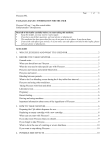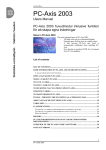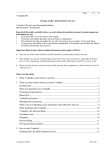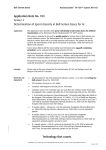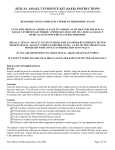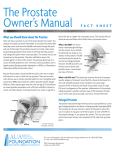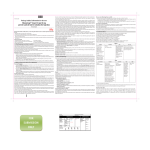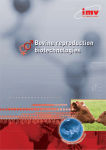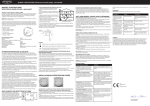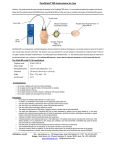Download Contraceptive - Noored noortele
Transcript
Contraceptive © Statens Folkhälsoinstitut –2003 Good Protection “Better to have love without children than children without love.” Hardly a controversial statement nowadays, but less than 90 years ago, it was enough to send its author, Hinke Bergegren, to jail. His crime? Promoting condoms as a weapon against poverty, illness and oppression. (The Swedish law that prohibited the publication of information on condoms from 1911 until 1938 was known as Lex. Hinke.) One hundred years ago, poverty was still widespread. Heavy manual work, lack of food and sleep, large families and overcrowded living conditions were all part of everyday life for large sections of the Swedish population. Poor health was rampant and mortality rates were high, not least among pregnant women, women giving birth and newborn infants. Sexually transmitted diseases raged across Europe, and Sweden was no exception. In these circumstances, there was a dire need for public education on sexual health. The pioneers of sex education saw an opportunity for individuals to take control of their own health, by choosing how many children to have and knowing how to prevent infection. In 1933 a dedicated campaigner called Elise Ottesen Jensen joined forces with a number of doctors and professional associations to form RFSU (the Swedish Association for Sex Education), which worked to promote contraception, sex education in schools, elective abortion and the decriminalization of homosexuality. Since that time, new forms of contraception and improved knowledge of the older methods have become widespread. The basic concept of reproductive health education remains the same: to provide people with the knowledge to choose the type of contraception that suits them best. Different people have different needs. Contraception is intended to prevent unwanted pregnancy and possible abortion, and to make sex safer – by protecting against sexually transmitted infections (STIs) and preserving fertility and sexual appetite. The best solution varies depending on the individual and their situation. No contraceptive is 100% reliable, but any method is safer than no contraception. Sometimes a combination of methods is the best solution. This booklet describes the forms of contraception currently available in Sweden, their advantages and their disadvantages. Whichever form of contraception you choose, you should treat your partner with love and respect. 1 Contents Page Fertilization................................................... 3 Withdrawal Method....................................... 3 Rhythm Method (Safe Periods) ..................... 4 Contraceptive Monitor .................................. 5 Breastfeeding ................................................ 6 Condom ........................................................ 6 Diaphragm .................................................... 7 The Pill ......................................................... 8 The Mini Pill............................................... 10 Contraceptive Implants................................ 11 Injectable Contraceptives ............................ 12 IUD (Copper Coil) ...................................... 12 IUS (Hormone Coil).................................... 13 Male Sterilization ........................................ 14 Female Sterilization..................................... 15 Emergency Contraception ........................... 15 Who do I turn to? ........................................ 17 2 Fertilization A man produces sperm (male reproductive cells) for most of his life once he has reached sexual maturity. Sperm are produced in the man’s testicles, inside his scrotum. The testicles also produce the male sex hormone, testosterone, a weak anabolic steroid necessary for the production of sperm. Various types of anabolic steroid occur naturally in the body. Taking additional anabolic steroids can interfere with the production of testosterone and, in the long run, sperm. Around 150 million sperm are produced daily, taking more than two months to develop fully. They leave the testicles through the vas deferens and are mixed with seminal fluid produced in the prostate gland and the seminal vesicles. A single ejaculation normally contains several hundred million sperm. Sperm can survive in a woman’s fallopian tubes for up to five days. When fertilization occurs, the man’s sperm fuses with the woman’s ovum (egg cell). A woman is born with hundreds of thousands of oocytes (egg mother cells). No more are produced during her lifetime. These tiny oocytes are held in the ovaries, located at the base of the pelvis, one on each side of the uterus. The uterus is shaped like an upside-down pear. The lowermost part, the cervix, can be felt at the top of the vagina. The upper part of the uterus is linked to the ovaries by the two fallopian tubes. Once a woman has reached sexual maturity, one ovum usually matures each month and is released by one of the ovaries. The ovulation (egg release) process is controlled by hormones. Women have two sex hormones, oestrogen and progestogen, which are produced in the ovaries. The ovum is picked up by one of the fallopian tubes, which carries it to the uterus. The ovum survives for only 24 hours. If it has not been fertilized, levels of progestogen fall dramatically after two weeks, causing bleeding – menstruation – from the uterus. When a man ejaculates during sexual intercourse, the sperm rapidly reach the fallopian tubes via the vagina and uterus. Sperm can remain in the uterus and/or the fallopian tubes for three to five days. If the woman ovulates during that time, the egg may be fertilized. Fertilization can therefore occur immediately or up to several days after intercourse. Fertilization usually takes place in the fallopian tube. The fertilized ovum is then carried down to the uterus, where it is implanted around a week after fertilization. Once the ovum has been fertilized, the woman will stop menstruating, because her body will then continue to produce progestogen. Note that ovulation occurs two weeks before menstruation, rather than a certain length of time after the woman’s previous menstrual period. If your periods are irregular, it is therefore impossible to predict when you will next ovulate. Withdrawal Method Breaking off sexual intercourse just before the man ejaculates is a common form of contraception used in many cultures since time immemorial. The principle is straightforward. The man withdraws his penis from his partner’s vagina when he feels orgasm approaching, thereby preventing sperm from entering the vagina. Reliability There are several risks inherent in this method. It is up to the man to react at the right moment and withdraw in time as he feels orgasm approaching. There may also be sperm present in the drops of pre-ejaculatory fluid. If he ejaculates too close to the mouth of his partner’s vagina, sperm may find their way into the vagina and uterus. The risk of fertilization increases if the 3 couple have sex again soon after the first ejaculation, as sperm may still be present in the penis. The risk may also increase if the man’s reactions are temporarily impaired by alcohol, for instance. It is estimated that up to 20% of women practising the withdrawal method become pregnant within a year. Nevertheless, this method always provides better protection against pregnancy than no precautions at all. (80–90% of sexually active women who do not use any form of contraception are estimated to become pregnant within a year.) Advantages The withdrawal method does not require any preparations or aids. Disadvantages The withdrawal method provides no protection against STIs. It can be difficult for the man and stressful for both partners. The woman has no control over the method’s reliability. Rhythm Method (Safe Periods) Using safe periods as a method of contraception means that you only have sex on those days when the risk of fertilization is low. The woman has to know when her ovulations and fertile periods are due, and she and her partner have to organize their sex life accordingly. Many couples use a combination of condoms and the rhythm method. Remember, ovulation occurs around 14 days prior to menstruation – not a set length of time after your last period. If your periods are irregular, or if you have just stopped taking the Pill, it is impossible to predict when you will next ovulate. Because sperm can survive in the uterus for up to five days after intercourse, the fertile period extends from five days before ovulation to one day after. Your menstrual cycle is calculated from the first day of one menstrual period to the first day of the next. The rhythm method is suitable only for women who menstruate regularly and have worked out when their safe periods are. For women who menstruate regularly every 28 days, the fertile period extends from Day 9 to Day 15, where Day 1 is the first day of the menstrual period. If you menstruate every 35 days, your fertile period is from Day 16 to Day 22. If you menstruate every 25 days, your fertile days are Day 6 to Day 12, in which case you have no safe days immediately after your period. Many women can feel themselves ovulating, but this does not mark the beginning of their fertile period. A woman’s body temperature normally rises by around 1°C owing to the production of progestogen following ovulation. You can determine your safe period post ovulation by monitoring your body temperature. You can also learn to recognize the mucus secretions produced in the cervix during your fertile periods. These secretions can be hard to identify, but books on the subject are available from your local library. 4 Reliability Couples who have mastered the rhythm method can make it work fairly reliably. However, at best it does not prevent around 20% of users from becoming pregnant within a year. Advantages The rhythm method does not interfere with your body in any way. Disadvantages The rhythm method provides no protection against STIs. It requires close attention and discipline on the part of both partners and can interfere with the spontaneity of your sex life. Suitability The rhythm method is suitable only for women who menstruate regularly. Use it only if you have worked out when your safe periods are. Contraceptive Monitor Contraceptive monitors (also known as personal contraceptive computers) are a very new form of contraception now on sale in pharmacies. They predict when a woman’s fertile periods and ovulations will occur. The monitor is a battery-powered box about the size of a spectacle case. It is pre-programmed with the “average” woman’s fertile periods but subsequently adjusts to the individual user. The monitor has to be opened daily, starting on Day 1 of your menstrual cycle. It displays a red, yellow or green light. A green light means the risk of becoming pregnant is minimal, and a red light means there is a high risk of pregnancy if you have unprotected sex. If a yellow light shows, the monitor needs more information, in the form of a test stick dipped in your overnight urine. The monitor analyses the stick and changes to red or green after a few minutes. You will need around eight sticks for each menstrual cycle, and more during the initial period. The method works by recording hormone levels in the body during the menstrual cycle. It measures the quantities of oestrogen (produced by the ovaries) and the ovulation hormone LH (from the pituitary gland) in the urine. In this way, the monitor can take account of the entire fertile period: both the time that sperm can survive before ovulation and the time during which the ovum can be fertilized. Reliability Used properly, the contraceptive monitor has a reliability rate of 94%. In other words, 6% of users become pregnant within a year. Advantages The contraceptive monitor is an option for couples who want a form of contraception that does not interfere at all with the body’s natural functions. It helps both the man and the woman to identify the fertile period. Disadvantages The contraceptive monitor is only suitable for women aged 20–45 who have regular periods and a 23–35-day menstrual cycle. It provides no protection against STIs and is suitable only 5 for couples in a steady relationship. It is not suitable for couples who require a contraceptive method that is virtually 100% reliable. Availability Contraceptive monitors and test sticks, complete with user instructions, can be purchased from pharmacies without a prescription. Breastfeeding People have known for centuries that women’s fertility is diminished while they are breastfeeding a child. Long-term breastfeeding remains a common method of family planning worldwide. Modern science has shown that breastfeeding provides good protection against pregnancy when three conditions are met: 1. The woman breastfeeds round the clock, without giving the child any other form of nutrition. 2. The woman has not started menstruating again after giving birth. 3. It is less than six months since the birth. All three of these conditions must be met if breastfeeding is to be an effective contraceptive. Reliability The risk of becoming pregnant is very small (1–2% of users) if all three conditions are met. Note that breastfeeding can be used as a contraceptive for a maximum of six months after you have given birth. Advantages This is a simple and practical method if you have no problems breastfeeding. Disadvantages If you have problems breastfeeding and are also feeding the child by other means (see above), you cannot use this method of contraception. It provides no protection against STIs. Contraception while breastfeeding Condoms, diaphragms or spermicides are suitable contraceptive methods for women who are only breastfeeding part time or who wish to use secondary contraception for other reasons. You can start using the Mini Pill, injectable contraceptives, contraceptive implants, IUD or IUS 6–8 weeks after giving birth. Combined oral contraceptives (the Pill) can affect breast milk and are not recommended for use while breastfeeding. Condom The condom is the only contraceptive that provides protection not only against pregnancy, but also against sexually transmitted infections. After celibacy, condoms are the best guarantee of safe sex for heterosexual and homosexual couples alike. 6 A condom is a very thin rubber sheath that is unrolled over the man’s erect penis. When he ejaculates, the condom catches the sperm. You need to use a new condom for each round of intercourse. Apart from sterilization, condoms are still the only contraceptive available for men. Condoms are supplied rolled up, in individual packages. They come in many different sizes, varieties, colours and even scents. The condoms sold in Sweden are of high quality and are subjected to regular durability tests. All types of condom can be used in combination with the spermicides and personal lubricants sold in Sweden. However, oil-based products such as Vaseline or massage oil will weaken the rubber. When the man withdraws after ejaculation, the condom should be held in place to prevent it from slipping off. Some types of condom are coated with lubricants and/or spermicidal agents and may slip off more easily. Reliability Among couples that use a condom to avoid pregnancy every time they have sex, around 2% of women become pregnant in the course of a year. However, many couples find it difficult to use a condom every time, which increases the degree of uncertainty. For the method to be safe, both partners must agree to always use a condom. If the condom bursts or slips off, the woman can avoid pregnancy by using emergency contraception (see below) within 72 hours. Advantages The condom is the only contraceptive that provides protection against STIs, so long as it is worn for the duration of intercourse. Disadvantages Men and women may both feel that condoms interfere with their lovemaking. Men who have difficulty getting an erection, for whatever reason, may have problems using a condom. Availability Condoms are sold at pharmacies, supermarkets, convenience stores, petrol stations and many other outlets, in a variety of pack sizes. Anyone who is allergic to rubber can use plastic condoms, available in pharmacies. Condoms are often distributed free of charge to young people. Diaphragm The diaphragm is a rubber cap inserted into a woman’s vagina so that it covers the cervix, thereby preventing sperm from entering the uterus. The diaphragm is used in conjunction with a spermicidal cream. It can be inserted at any time before intercourse and must remain in place for at least six hours afterwards. It should not be left in place for more than 24 hours at a time. If more than one hour has elapsed since you applied the spermicidal cream, you should reapply it. You can wash the diaphragm using soap and water, and it will normally last for several years. Reliability Among those using the diaphragm every time they have sex, 3–4% of women become pregnant within a year. The degree of uncertainty increases if you don’t always use the diaphragm. 7 Advantages Used in combination with spermicidal cream, the diaphragm provides a certain amount of protection against STIs and cell mutations in the cervix (but not as much protection as a condom). Apart from the minimal risk of a rubber allergy, it has no side-effects. Disadvantages Use of the diaphragm requires advance planning and great care on the part of the woman. The diaphragm must be fitted by a midwife or a gynaecologist, and the user has to learn how to insert it correctly. A few women find it completely unsuitable. Women and men may both feel that the spermicidal cream is messy, or that the necessary preparation prevents spontaneity in their sex life. Availability Diaphragms can be bought from pharmacies after fitting by a midwife or doctor. Spermicidal cream is available from pharmacies. The Pill The most common type of contraceptive pill is the combined oral contraceptive, usually known simply as the Pill. It contains a combination of the female sex hormones oestrogen and progestogen. The Pill comes in many different types, containing different quantities and combinations of hormones. The principle on which they all work is the same: they prevent ovulation and hence fertilization. When a woman is on the Pill, her ovaries remain inactive, in the same way as they do when she is pregnant or breastfeeding. The Pill also causes the cervical mucus to thicken so that sperm cannot penetrate the uterus. A course of the Pill normally starts on the first day of your menstrual period. If your periods are infrequent, you can start taking the Pill without waiting for your period, in which case you should not rely on it to protect you against pregnancy during the first 10 days. You can also start on the Pill immediately after an abortion or miscarriage, or after taking the morning-after pill. The Pill normally comes in packs of 28 tablets. The first 21 tablets contain the hormones that prevent ovulation, while the remaining seven tablets are simply there to ensure you keep up the habit of taking a tablet a day. During this fourth week of the cycle, you will normally experience bleeding as you would during a period. Packs containing 21 tablets only are also available. If you use these, you should stop for a week after finishing a pack, and again you will normally experience a period-like bleed. Many types of Pill contain the same quantities of hormone in each tablet, and all the tablets are the same colour. Other types of Pill contain varying amounts of hormone, as indicated by colour-coded tablets. Packs containing three or four different colours, and three different quantities of hormone, are often known as the triphasic Pill. All types of Pill protect against pregnancy even during the week when you are not taking any tablets containing hormones. During that week, you will normally experience bleeding from the uterus. If you experience spotting (additional bleeds) or do not bleed at all, you should see a doctor or midwife. 8 Your ability to conceive returns when you stop taking the Pill. Normally the effects wear off after a few days, but sometimes you may have to wait several months for your first ovulation and period. The Pill never causes infertility. Reliability If you follow the instructions for taking the Pill, it is an extremely reliable contraceptive. In the course of a year, fewer than 1% of women on the Pill become pregnant. Its reliability diminishes if it is used incorrectly. The tablets should be taken around the same time each day. If more than 36 hours have elapsed between tablets (i.e. you forgot for more than 12 hours), then you will need to use secondary contraception (condoms) for a week. Usually the combined Pill provides effective contraception even when you have forgotten to take a tablet, but it is important that you don’t break for too long between packs. Vomiting or diarrhoea can reduce the effectiveness of the Pill, so you should use secondary contraception for a week afterwards. (For this reason, the Pill is unsuitable for women who suffer from certain intestinal ailments.) Some medications can counteract the effectiveness of the Pill, so you should always discuss this with your doctor or midwife before going on the Pill. Spotting may be a sign of reduced effectiveness. Advantages The combined Pill is a very reliable contraceptive which does not interfere with your lovemaking. It gives the woman control of her own fertility, which returns as soon as she comes off the Pill. Other advantages include: • • • Regular menstruation, with the user being able to decide the timing of her periods Less heavy periods, and hence less risk of haemorrhage No ovulation pains and less risk of period pain The combined Pill can also benefit women’s health in various respects, for example: • • • • • • Reduced risk of ovarian cysts Reduced risk of salpingitis (inflammation of the fallopian tubes), improving the user’s ability to conceive if she so wishes Reduced risk of endometriosis (whose symptoms include severe stomach pains during menstruation) Reduced risk of ectopic pregnancy (where the embryo grows outside the uterus) Reduced risk of ovarian and cervical cancer Reduced risk of certain ailments of the joints Some types of Pill also have a beneficial effect on acne. Disadvantages The Pill provides no protection against STIs. During their first few months on the combined Pill, up to 20% of users suffer intermittent spotting. Some users may also experience depression and/or reduced libido. Other possible side-effects include tender breasts, slight nausea, and weight gain as a result of increased appetite. 9 The combined Pill also slightly increases the risk of thrombosis (blood clots), but this risk is extremely low: less than 1 in 10 000. However, women with a history of thrombosis, or whose parents, brothers or sisters suffered thrombosis before the age of 50, are advised not to take the combined Pill. Smoking increases the risk of cardiovascular disease, so heavy smokers aged over 35 are advised against taking the combined Pill. (For healthy, non-smoking women, there is no age limit.) Women who are severely overweight are likewise advised against taking the combined Pill. You should also avoid the combined Pill in the following circumstances: • • • • You have previously undergone heart-valve surgery. You have a history of breast cancer. You suffer from chronic liver problems. You are confined to bed or immobilized following a major operation or an accident that has left you in plaster. There has been much discussion regarding a possible connection between the Pill and breast cancer. The research findings are contradictory. Numerous studies have shown no increased risk. Availability The Pill must be prescribed by a midwife or a doctor and is available from pharmacies. The cost varies depending on the type. Some county councils offer the Pill at reduced prices to younger women. The Mini Pill The Mini Pill is an oral contraceptive containing only one of the female sex hormones, progestogen. The Mini Pill works in two ways: It causes the cervical mucus to thicken, making it difficult for sperm to penetrate the uterus, and it acts on the uterus to prevent the ovum from implanting easily. It may also affect the ovaries and prevent ovulation. You must take the Mini Pill every day without interruption (even during your period). Normally you will have a period once a month, but irregularities such as spotting and missed periods are common. The first tablet is taken on Day 1 of your period, or the day after an abortion or miscarriage. The tablets are fully effective from Day 1. You should take your tablet at the same time each day. If more than 30 hours have elapsed between tablets (i.e. you forgot for more than six hours), then you will need to use secondary contraception (condoms) for a week. Reliability If you follow the instructions for taking the Mini Pill, it provides effective contraception. On average, 1% of women on the Mini Pill become pregnant in the course of a year. Missing a pill, diarrhoea, vomiting and certain medications reduce its effectiveness. 10 Advantages The Mini Pill is usually a good option for women who have been advised against combined oral contraceptives containing oestrogen (the combined Pill). The Mini Pill can be used while breastfeeding, since unlike the combined Pill it has no effect on breast milk. Disadvantages The Mini Pill provides no protection against STIs. Erratic bleeding may give cause for concern. If you go more than two months without a period, you should take a pregnancy test. Availability The Mini Pill must be prescribed by a midwife or a doctor and is available from pharmacies. The cost varies depending on the brand. Some county councils offer the Pill at reduced prices to younger women. Contraceptive Implants Contraceptive implants contain the same hormone as the Mini Pill, progestogen. It causes the cervical mucus to thicken, making it difficult for sperm to penetrate the uterus, and it acts on the uterus to prevent the ovum from implanting easily. It may also affect the ovaries and prevent or disrupt ovulation. The implants are inserted under the skin inside the upper arm under local anaesthetic. There are two types of contraceptive implant: One is a single plastic rod, 4 cm in length and the thickness of a match, in which the hormone levonorgestrel is embedded. This type provides effective contraception for three years before it needs to be replaced. The other type consists of six rods in which the hormone levonorgestrel is encapsulated in soft silicone. These rods are inserted under the skin inside the upper arm under local anaesthetic. The implant provides effective contraception for three to five years, after which it needs to be replaced. It can be removed sooner if you wish. Ovulation resumes and fertility returns as soon as the implant is removed. Reliability Implants are a very reliable form of contraception. Statistics show that fewer than 1% of users become pregnant in the course of a year. Unlike the Pill, their effectiveness is not impaired by stomach upsets or forgetfulness on the part of the user. Advantages Implants remain effective for a long time, and you don’t have to worry about remembering to take the Pill. Disadvantages Implants provide no protection against STIs. Erratic bleeding is common but often reduces over time. You may not have any periods while the implant remains in place. Known sideeffects include tender breasts and mood swings. Acne may be exacerbated. 11 Availability Implants are available on prescription from pharmacies. The operation to insert or remove them can be carried out at any gynaecology clinic and by family doctors with the necessary equipment. Injectable Contraceptives Like the Mini Pill, contraceptive implants and the hormonal IUD, injectable contraceptives contain only progestogen, but in a higher dose. This stops ovulation and affects the uterus, causing a change in the woman’s menstruation pattern. One injection in the buttocks every three months is enough to provide complete protection against pregnancy. You should have your first injection at the earliest opportunity during your period or after an abortion or miscarriage. You can also use injectable contraceptives while breastfeeding, starting around six weeks after giving birth. Reliability Injectable contraceptives are very reliable, providing almost 100% protection. Advantages This is an easy and reliable method. Users avoid the side-effects associated with oestrogen, which makes this a suitable method for many women who are advised not to use the combined Pill. After several years of contraceptive injections, around half of users stop menstruating and thus avoid premenstrual syndrome while they continue to receive injections. Disadvantages Injectable contraceptives provide no protection against STIs. Many users suffer erratic bleeding, particularly in the early stages of treatment. Long gaps between periods are also common, and gradually menstruation may cease altogether. In such cases, you should take a pregnancy test after two months and a further test after another month or so. If both tests are negative, you can be sure you are not pregnant despite your lack of periods. It may take up to a year for ovulation to resume after a contraceptive injection. For this reason, the method is seldom used by young women who may wish to have a child in the near future. Side-effects include mood changes, and weight gain as a result of increased appetite. Availability Injectable contraceptives must be prescribed by a midwife or a doctor and are available from pharmacies. The injection is given by a midwife or a nurse. IUD (Copper Coil) The first modern intrauterine devices (IUDs) were made of plastic and looked like coils, hence the nickname. Today’s IUDs are about a centimetre in length and consist of a T-shaped plastic stem with copper wire wound around the shaft and sometimes also the “T-bars”. 12 By releasing copper, the IUD creates a hostile environment for ovum and sperm, thereby preventing fertilization. The IUD is fitted following a gynaecological examination. It can be removed at any time, but can be left in place for 5–10 years before it needs to be changed. The woman’s fertility returns as soon as the IUD is removed. The quantities of copper released by the IUD are lower than those present in food. Most of the copper accumulates in the mucous membranes of the uterus and is expelled during menstruation. Although some users develop an allergy to copper, this is very rare. Reliability The IUD is a very reliable contraceptive, with fewer than 1% of users becoming pregnant in the course of a year. If you become pregnant in spite of the IUD, you should have it removed, since it will increase the risk of miscarriage while it remains in place. It does not increase the risk of fetal damage. Advantages The IUD affects the uterus and fallopian tubes but no other parts of the body. Copper IUDs contain no hormones. Disadvantages The IUD provides no protection against STIs. If you contract an STI such as chlamydia, there is an increased risk of it spreading to the fallopian tubes if you have an IUD. The IUD is therefore most suitable for women in steady relationships. The IUD may cause longer, heavier periods, but non-prescription tablets are available to counteract this. You may also experience heavier vaginal discharges. In exceptional cases – no more than 1 in 1 000 – the IUD may become dislodged from the uterus, particularly in women who had it fitted after giving birth and are breastfeeding full time. However, there is no truth in the suggestion that IUDs can migrate to other parts of the body. Very rarely, an IUD may be expelled during a heavy period without the user’s knowledge. You can check for yourself whether the IUD is in place by feeling for two fine threads at the top of your vagina. Availability The IUD is fitted by a midwife or a doctor after a standard gynaecological examination. Copper IUDs are supplied free of charge. IUS (Hormone Coil) Like the Pill, contraceptive implants and injectable contraceptives, this is a hormone-based method, but in the form of an intrauterine system (IUS). The IUS is inserted into the uterus in the same way as a copper IUD. The T-shaped plastic stem is identical, but instead of copper wire around the shaft, the IUS has a silicone sleeve that releases progestogen. The IUS acts on the uterus and the cervical mucus so that it cannot be penetrated by sperm. The woman’s fertility returns as soon as the IUS is removed. 13 Reliability The IUS is an extremely effective contraceptive with almost 100% reliability. Advantages An excellent form of contraception for women who have heavy periods. Levels of progestogen in the body outside the uterus are very low, and hormone-related side-effects are rare. The IUS can remain in place and fully effective for five years. Disadvantages The IUS provides no protection against STIs. It is therefore most suitable for women in steady relationships. The effect of progestogen on the uterus leads to irregular, increasingly infrequent periods, which may cease altogether after a time so long as the IUS remains in place. Ovulation does not normally stop, even if menstruation does. Some users may suffer from acne. Sometimes the insertion of the IUS can be painful, but an anaesthetic is seldom required. Very rarely, an IUS may be expelled during a heavy period without the user’s knowledge. You can check for yourself whether the IUS is in place by feeling for two fine threads at the top of your vagina. Availability The IUS must be prescribed by a midwife or a doctor and is available from pharmacies. Male Sterilization Under Swedish law, anyone over the age of 25 may undergo sterilization. This is a permanent method of contraception which must be regarded as irreversible. So you have to be sure that you won’t want children at a later date, whatever else happens in your life. Anyone contemplating sterilization must consult a counsellor or a doctor. It is vital that any decision is based on a personal desire not to have children in future. Male sterilization, or vasectomy, involves cutting the vas deferens (the tube that carries the sperm) so that no sperm can get through. The surgeon makes a small incision on either side near the top of the scrotum, where the tube is easily accessible. The operation is performed under local anaesthetic, and the patient can go home the same day. Sperm remain in the seminal vesicles for some time after vasectomy, so you will have to continue using contraceptives as usual for about three months, until semen tests show a negative sperm count. Sterilization has no effect on the male sex hormones or the man’s sex drive. Reliability After the first few months, male sterilization is virtually 100% effective. Advantages The man no longer needs to worry about contraception or causing unwanted pregnancy. 14 Disadvantages Sterilization provides no protection against STIs. Younger men in particular may later regret their decision. Availability Male sterilization is performed by the surgical or urological clinic at many hospitals. Female Sterilization Under Swedish law, anyone over the age of 25 may undergo sterilization. This is a permanent method of contraception which must be regarded as irreversible. So you have to be sure that you won’t want children at a later date, whatever else happens in your life. Anyone contemplating sterilization must consult a counsellor or a doctor. It is vital that any decision is based on a personal desire not to have children in future. Female sterilization, or tubal ligation, involves cutting the fallopian tubes so that no ovum can reach the uterus. The operation is usually performed under general anaesthetic using keyhole surgery. The surgeon makes a small incision close to the navel and inserts a surgical instrument with a telescopic sight through the abdominal cavity to the fallopian tubes. Usually the patient can go home the same day. In women, sterilization takes effect immediately. Neither hormone production nor sex drive is affected. Reliability Female sterilization is virtually 100% effective. Advantages The woman no longer needs to worry about contraception or unwanted pregnancy. Disadvantages Sterilization provides no protection against STIs. Younger women and childless women in particular may later regret their decision. Availability Female sterilization is performed by the gynaecology clinic at many hospitals. Emergency Contraception There are two types of emergency contraception – oral tablets (“morning-after pills”) and IUD – that can be used after unprotected intercourse at the time of ovulation. They can also be used if your normal method of contraception has failed – say the condom burst or you forgot to take the Pill. Emergency contraceptive pills are also offered to rape victims. A morning-after pill for regular use is not yet available. 15 The Morning-After Pill The morning-after pill has to be taken within 72 hours of unprotected sex. Two doses are taken, 12 hours apart. The sooner you take the tablets after intercourse, the more effective they will be. Even if you have been advised not to use the Pill regularly, you can safely take a short course of emergency oral contraception. To be fully effective, the morning-after pill should not be used more than once a month. It is not an abortifacient and will not reverse any fertilization that has already taken place. Prior to treatment, pre-existing pregnancy should be ruled out, by means of a pregnancy test if necessary. Another test should be carried out three weeks after treatment to confirm that you have not become pregnant. If you decide you want to use the Pill as regular contraception, you can start taking it immediately after the emergency contraceptive treatment. There are two types of emergency oral contraception: The Levonorgestrel method involves progestogen-only pills (like the Mini Pill). You have to take two single tablets, approximately 12 hours apart. The Yuzpe method involves combined oral contraceptive pills containing both oestrogen and progestogen (like the regular Pill). You have to take two doses of two tablets each, with 12 hours between doses – a total of four tablets. If the tablets cause vomiting within two hours of taking them, you must take another two tablets. Reliability The Levonorgestrel method is somewhat more reliable than the Yuzpe method. The risk of pregnancy is 1–3%. The morning-after pill is not as reliable as the ordinary Pill or IUD and should not be used as a substitute for other forms of contraception. Advantages Taking the morning-after pill saves many women from needing an abortion. Disadvantages Side-effects, which are more common with the Yuzpe method, include nausea, vomiting and dizziness. The morning-after pill can only be used once in each menstrual cycle. If you use it for several cycles in succession, its effectiveness is reduced. Emergency contraception does not provide protection against STIs. Availability In an emergency, tablets can be obtained by visiting a youth clinic, maternity centre or gynaecology clinic. Levonorgestrel tablets are also available from pharmacies without a prescription. Emergency IUD A fertilized ovum does not implant in the uterus until a week after intercourse, or later if the sperm had to wait for ovulation. 16 In an emergency, a copper IUD can be fitted up to five days after unprotected sex and will still provide full protection. The effectiveness, reliability, advantages and disadvantages are the same as for IUDs in general. If there is a risk that you might have contracted an STI, you should opt for the morning-after pill in preference. Who do I turn to? All contraceptive advice is free of charge. You are always welcome to visit your nearest advice centre, whether you just want information on contraceptive methods or need help choosing or changing your method. If you have any questions about contraception, you will find various clinics listed in the telephone directory under your county council (Landstinget). These may include: • • • • • • Familjeplanering (family planning) Mödravårdscentral (maternity centre) Ungdomsmottagning (youth clinic) Preventivmedelsmottagning (contraception clinic) Kvinnoklinik (well-woman clinic) Gynekologmottagning (gynaecology clinic) Contraceptive information is also available from family doctors, school nurses, sex advice services, RFSU (Swedish Association for Sex Education) and other outlets. 17


















